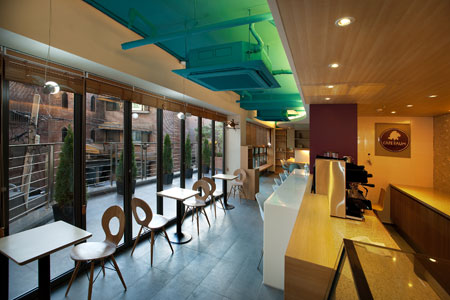- California Assembly OKs highest minimum wage in nation
- S. Korea unveils first graphic cigarette warnings
- US joins with South Korea, Japan in bid to deter North Korea
- LPGA golfer Chun In-gee finally back in action
- S. Korea won’t be top seed in final World Cup qualification round
- US men’s soccer misses 2nd straight Olympics
- US back on track in qualifying with 4-0 win over Guatemala
- High-intensity workout injuries spawn cottage industry
- CDC expands range of Zika mosquitoes into parts of Northeast
- Who knew? ‘The Walking Dead’ is helping families connect
‘Share houses’ getting popular in Korea

The communal space of Maibaum Yunhee, the country’s first commercial
“share house” complex in Yeonhee-dong, Seodaemun-gu, Seoul.
(Coutesy of Soomok Architecture)
By Joel Lee
So-called “share houses” are becoming popular among young urbanites. These are houses where tenants share communal bathrooms, kitchens and living rooms, while having their own bedrooms.
It is a kind of “gentrified” studio-apartment with communal space for socializing. The concept, sensible at a price, has struck a chord with many young adults longing to settle their restless nomadic lives.
“I really love the communal space where I can cook, read books, and socialize with co-tenants,” said Park in her 20s, a tenant of Maibaum Yunhee, the country’s first commercial share house complex in Yeonhee-dong, Seodaemun-gu. “It makes me feel connected in a big city like Seoul. We sometimes go out together or bring friends for a party.”
Maibaum Yunhee consists of 37 residential units on six floors, with a kitchen and a terrace. Monthly rental ranges from 500,000 to 700,000 won.
“I can make better use of my room with the cooking facility moved out into the communal space,” another tenant said, declining to be named.
Woozoo is another share-house brand springing across various locations in Seoul. Each branch is developed to a particular theme such as entrepreneurs-hopefuls, art devotees, university graduates, travel lovers, movie aficionados, bookworms, slow lifers, and culinary devotees.
Yoon Sun-ho, the marketing manager of Woozoo, said the company originally started as a form of social enterprise by four young men for solving their housing needs.
It remodels old or vacant homes after signing a “jeonse” or monthly rental contract and re-leases them to young university students or graduates. Monthly rental ranges between 350,000 to 650,000 won.
The Seoul Metropolitan Government (SMG) has also initiated a share-house-type public rental housing program through its unit SH Corp.
It plans to provide up to 410 units of public housing to singles, university students, and the elderly in the neighborhood. It is running a pilot project, dubbed “Durae Housing,” in Banghak-dong, Dobong-gu.
Jin Hee-sun, director general for residential rehabilitation division of SMG, said, “Durae Housing, is significant in that it is a new form of public rental housing effectively able to accommodate a single person or a couple in line with diversifying household types.”
Relationship-seeking has been the embryonic background for the birth of share-houses in Korea.
In an era of individualism and avant-garde lifestyles, young Koreans experience a flood of relationships online through social networking services, but offline they have fragmented friendships.
Koyabe Ikuko, the author of the book “Collective House,” said the “collective housing movement can inspire people to formulate relationships with their community based on each individual’s freedom and autonomy.”
Single-person households are expected to account for one third of the total by 2035, according to Statistics Korea.
However, the urban small housing units are greatly lacking amid the rise of low-income, single-person households, such as university students from outside the capital, young office workers, and foreign laborers.
Experts expect the share-house to firmly secure its place in the future housing market as a new mode of residential unit. In a densely populated compact city such as Seoul, such a compact life seems both promising and pressing.
The writer is an intern of The Korea Times











